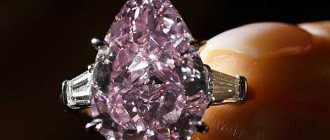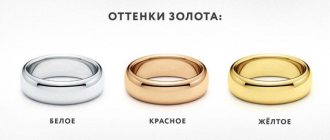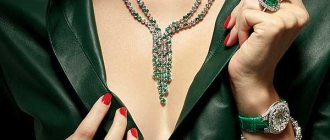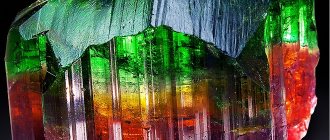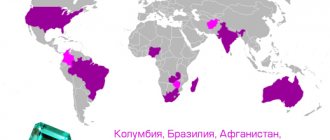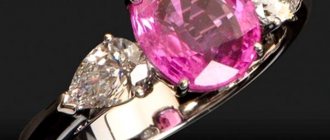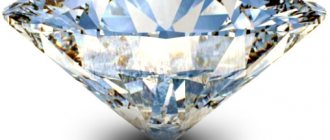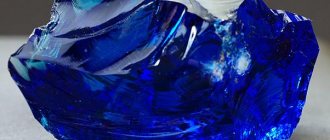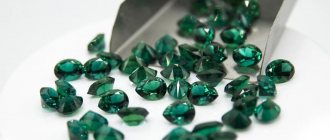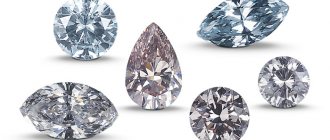A lady finds herself in a difficult situation when she finds herself in a store hoping to choose some jewelry for herself. The stones sparkle and shimmer, the price tags are confusing, the tags do not clarify anything - in general, the situation is almost hopeless. Sellers are ready, in principle, to answer any question, but what to ask is unknown. You can’t ask a nice girl: “Is that green one over there a good stone? Isn’t it a fake?”
Precious stones, transparent and hard, are rare in nature and therefore are expensive. These include diamond, natural pearl, sapphire, emerald and ruby.
However, diamond occupies a special place among them. It combines exceptional hardness, high light refraction and high gloss.
Diamond
Diamonds are made up of pure carbon atoms that exist deep underground, subjected to intense heat and pressure over billions of years.
What can it be confused with?
The greatest similarity is found in cubic zirconia (colorless zircon created by laboratory synthesis at the Physical Institute of the P.N. Lebedev Academy of Sciences). Although they are very similar in appearance, if you look closely, cubic zirconia gives less colorful highlights. Beryl, sapphire, topaz, and quartz are also passed off as diamonds.
Price
Diamonds are piece goods. A high-quality diamond weighing 1 g costs hundreds of thousands of rubles.
Tips for choosing
Let's try to understand the mineral according to the parameters indicated on the price tag.
The cost of any gemstone is made up of four factors: weight, shape, color and quality.
Weight is measured in carats (in ancient times, this word was used to describe special seeds with which the size of a pebble was compared). 1 carat is equal to 0.2 g. The price per carat increases with the weight of the diamond. A particularly sharp jump in price is observed at the 1-carat mark, when the price of identical stones weighing 0.99 carats and 1 carat differs by approximately 1.3 times, since it is believed that a “real” diamond starts at 1 carat. Depending on their weight, diamonds are divided into small (up to 0.29 carats), medium (from 0.30 to 0.99 carats) and large (more than 1 carat). If the diamond is too small, its mass is measured in “points”, which are 0.01 of the carat, that is, only 2 mg.
Form. This is the type of cut: round, oval, etc. This determines how the stone “plays” and glows. Round shape (Kr) is the most common option. Ovals and hearts are cut less frequently and are cheaper. The cut can be simplified, with 17 facets (Kr-17) (for small stones) and complex - with 57 and 58 facets (Kr-57). Another point that influences the evaluation of a stone is the quality of the cut (symmetry, polishing, etc.), evaluated by the letters “A”, “B”, “C”, “D”, where the first one denotes the highest class.
Color. Due to the peculiarities of the diamond formation process, only a few specimens are truly colorless stones. The more colorless a “white” diamond is, the higher its value. These rules do not apply to fancy colored diamonds. Such diamonds come in blue, pink, red, yellow, and green. They are very rare, and their cost is several times higher than the cost of “white” diamonds. Diamonds are classified into color groups from colorless with a gradual increase in saturation to yellow, brown, and gray shades. The number of color groups depends on the weight. Small Kr-17 diamonds are classified into 4 color groups (1 – colorless stones). Small Kr-57 diamonds are classified into 7 color groups (1 - colorless stones). Medium and large diamonds are classified into 9 main color groups (1 - colorless stones).
Purity. Diamonds are classified into clarity groups depending on the presence of internal characteristics (inclusions, cracks, surface defects, the elimination of which will lead to significant weight loss), their quantity, location and color (characteristics visible through a 10x magnifying glass are taken into account). Although these shortcomings make the product unique, their presence still makes the product cheaper. The quantity depends on the weight. Thus, small Kr-17 diamonds are classified into 6 purity groups, and small Kr-57 diamonds into 9 groups. For medium and large stones there are 12 purity groups. The relationship between color and clarity is usually expressed as a fraction, with the larger the numerator and denominator, the lower the quality of the stone. For example, a diamond with a characteristic of 3/3 is considered good, but a fraction of 9/12 indicates a very low quality of the stone.
We translate from jewelry
The “coding” of a diamond’s quality looks something like this: Kr57A-0.47-3/5. Translation from jewelry:
- Kr57A - has a round cut shape (Kr) with 57 facets (57) of very high quality (A).
- 0.47 - the second number indicates the size of the stone. Weighs 0.47 carats, that is, medium in weight.
- 3 - the penultimate number on the label indicates the degree to which the color of the stone differs from white (transparent).
- 5 - the last digit indicates the class of “purity” or quality of the stone. Our sample has few foreign inclusions.
Summary
An ideal diamond weighs from 1 carat, round grade A cut with 57 facets, colorless, pink or blue, with a color/quality ratio of 1/1 to 3/3.
Which stone is more expensive: ruby, sapphire, emerald or diamond?
Ruby
Each gem included in the precious four has first-order status. The debate over “which stone is more expensive” has probably been going on for centuries. For some reason, many people mistakenly believe that diamonds, the processed form of a diamond, are valued more than all others, but this position is at least incorrect.
Each of the crystals is unique in nature, has many varieties, and difficulties associated with their extraction and evaluation. The cut of the stone and which craftsman or company made it will play an important role in your choice.
Having asked a jeweler about the choice between sapphire or emerald, he can argue endlessly, leaving the question unanswered, only filling his head with examples and facts. For an accurate answer to this question, it is worth referring to the history of each stone, its characteristics, processing, evaluation and, of course, the price list for each stone presented.
Pearl
Natural pearls are formed in the body of an oyster if some foreign body, such as a grain of sand, gets there. The mollusk tries to get rid of it by secreting nacre, which envelops the alien, trying to neutralize its activity. The longer the pearl remains in the oyster's body, the thicker the layer of nacre around it will be. This creates a beautiful shiny gemstone - a pearl.
Natural pearls belong to the category of the rarest and most expensive precious stones. Pearls are not processed by jewelers - they are used in their original form.
What can be confused with
Nowadays, most pearls sold in stores are cultured specimens, grown with the help of humans (a bead is placed in an oyster, after which the pearl formation process continues in the same way as in nature). It is believed that cultured pearls have the same properties as natural pearls. The main difference between natural and cultured pearls is that cultured pearls are harvested much earlier than natural ones, and therefore the layer of nacre on them is very thin.
Price
The price of the final product will depend on the color, growing conditions (sea or river water), thickness of the pearlescent layer, surface gloss, size and shape. As the size increases, the price increases unevenly: a 9 mm pearl costs twice as much as an 8.5 mm pearl. At the same time, river pearls are traditionally valued less than sea pearls. There are no perfectly round pearls, so rounded ones are valued more than crooked ones, but non-standard specimens shaped like snails, for example, are also not cheap. Naturally colored pearls cost more than white pearls, while artificially colored pearls cost less. White and pink pearls are most valued, followed by gold (champagne) and black (Tahitian).
Color
Pale pink, silver, yellowish, light green, white, black, rose red. Sizes range from microscopic to a pigeon egg.
Tips for choosing
If you decide to purchase pearls, compare the quality of what is offered in stores. Take a closer look at the product as a whole: the shine is good, but the roundness is not important; shine and color are normal, but the surface is uneven; The shape is good, but there is no harmony among the pearls in the string.
Place the pearls on your neck or face and make sure their color matches your skin and hair color. Ask if the color is natural. Freshwater pearls are easy to distinguish from sea pearls: they are small and shaped like crooked pearl grains.
Summary
The ideal pearl is natural, marine, shiny and smooth to the touch, without potholes or depressions, round in shape, large in size, white, pink or gold in color.
Where are rubies mined?
They say that the gem is not found only in Antarctica. However, despite its widespread use, specimens of decent quality are rarely found. The best crystals are Burmese. This is where the most expensive untreated pigeon's blood rubies come from. Good quality Mozambican and Indian gems. Red corundums are also supplied by Afghanistan, Sri Lanka, Thailand, Kenya, and Tanzania.
The most beautiful red corundums are considered to be the Edwards Ruby, kept in the British Museum of Natural History; "Riva", star ruby from the American Smithsonian Institution; "De Longa", also stellate, from the New York Museum of Natural History. The most expensive copy, worth $12 million, belongs to the Sultan of Brunei. Its weight is 25 carats.
The ruby mineral in Russia is mined in the Urals, but there are no pure ruby deposits; gems are found “along the way,” during the mining of other precious stones. Some specimens are found in the Pamirs.
Sapphire
Sapphire is known in the mineral world as corundum, whose crystal structure is composed of aluminum oxide. On the hardness scale, sapphire is the hardest gemstone after diamond.
Color
Rare stones of rich cornflower blue color are considered the most valuable. More often there are simply blue, green, yellow, white, pink and brown stones.
What can be confused with
Often the role of sapphire is painted cubic zirconia.
Tips for choosing
The origin of a sapphire greatly influences its value. The homeland of the best sapphires is Kashmir. The color of these stones is cornflower blue. In addition, Kashmir sapphires retain color under artificial light, which is rare for this crystal.
Price
Natural sapphires are very rare and expensive. The purer the blue color of natural sapphire, the higher the price. Darker or paler stones have less value. The price is also affected by the brightness and cut of the stone and the carat weight. The best quality sapphire is one whose purity is visible to the eye, and some inclusions are detectable under a magnifying glass. Sapphires weighing up to 2 carats are more common, but stones from 5 to 10 carats are also found.
However, a gemological3 certificate confirming that the mineral was mined in Kashmir does not yet guarantee its high quality. Burmese sapphires can also be of excellent quality. Sapphires from Sri Lanka are usually paler. The darkest and therefore cheapest sapphires are mined in Australia.
Summary
It is better to look for a sapphire from Kashmir, pure cornflower blue in color, with a good cut, weighing several carats, the inclusions of which should not be visible to the naked eye.
Properties of stones
Emerald is a mineral that belongs to the beryl group of stones. This stone is completely transparent. In nature, emerald has a rich green color, which is explained by the presence of chromium oxide and vanadium oxide in its composition. When exposed to high temperatures (700–800 degrees), the color of the emerald may fade.
According to the Mohs scale, the hardness of a gemstone is rated at 8 points out of 10. It is almost impossible to find flawless emeralds in nature; the presence of the finest scratches, cracks and splits on the stone is considered the norm. Zonal coloring is also characteristic of these stones. In most cases, crystals with an intensely colored central part are found in nature. There may also be minerals in which the brightness of the color changes along their long axis.
As for the size of emerald, small specimens are most valued in the jewelry industry, since they are mostly transparent. To process such stones, diamond and step cuts are used.
As for gems with significant weight, transparent emeralds are not found among them, since such stones contain inclusions of mica. Such minerals are processed in the form of cabochons. Mined emeralds are refined using cedar oil, opticon, Arthur Groom's hematrat and parmaseif. These products are used to fill cracks in minerals, which increases the aesthetic appeal of gems. However, we should not forget that the intensity of stone processing directly affects their value and cost.
Deposits of such gems are concentrated in South America (Brazil, Colombia, Chile, etc.) and Asia (Pakistan).
Emerald is a first-order gemstone. This group also includes minerals such as diamonds, rubies and sapphires (exclusively blue ones!). The latter, like emeralds, are also in demand in the jewelry industry.
Sapphire, which belongs to the class of oxides, is a precious variety of corundum. This mineral is hard and is rated 9 on the Mohs scale. Sapphire may contain impurities of vanadium, titanium, iron and other elements. The gem has the shine of a diamond, but at the same time it can be either transparent or opaque.
Sapphire is not a rare mineral, since there are many places on the planet where it can be mined. The largest of them are located in Thailand, India, Brazil, USA, Australia, and Sri Lanka. There are deposits of the mineral in some European countries.
The color palette of sapphires is varied:
- Cornflower blue sapphire: considered the most valuable stone among all sapphires. All cornflower blue minerals can be divided into Burmese and Kashmir sapphires. They are considered rare and therefore expensive. Deposits are concentrated in Australia, Cambodia, Sri Lanka and Madagascar.
- White: It is almost impossible to find because it is very rare in nature, which is why it is not used in the jewelry industry. Therefore, it is worth knowing that the transparent sapphires offered in jewelry stores are guaranteed to be fake.
- Purple: the color of this gem is achieved due to the presence of titanium and iron impurities in its composition. Sapphire is mined in Sri Lanka.
- Padparadscha: It is notable for the fact that it has several shades on the surface - orange, pink and purple. In the jewelry industry, these stones can only be used if the weight of one mineral does not exceed five carats.
- Yellow: Considered the most common color, it can be used in gemstone jewelry. The shade of the gem ranges from bright yellow to golden.
- Green: differs from the rest in that it has inclusions and veins that give the mineral a heterogeneous color.
Earrings with sapphires
All sapphires, with the exception of blue ones, used in the manufacture of jewelry can be heat treated. Before cutting, minerals are heated to 1800 degrees Celsius, and exposure to high temperatures lasts up to several hours.
Emerald
Emerald is one of the most revered and expensive gemstones. The stone belongs to the beryllium genus, whose crystal structure consists of aluminum and beryllium. Unlike other green stones, it retains its color under artificial light.
Most natural emeralds have cracks and internal defects visible to the eye, and uneven coloring.
Price
The brighter the green, the higher the cost. Unlike a diamond, a beautifully colored emerald does not lose much in value if it contains inclusions. Natural emeralds of the highest quality weighing more than 2 carats are very rare and very expensive.
What can be confused with
A stone that is too pale in color may not be an emerald, but ordinary beryl or inexpensive fluorite. You can distinguish natural emeralds from synthetic ones based on the fact that most natural emeralds are imperfect, have cracks, and are opaque in places. Perfect dark green and perfectly transparent emeralds will most likely turn out to be high-quality synthetics.
Color
There are five types of emeralds: dark green, normal green, medium green, light green, light green. The most valuable are emeralds, the color of which is close to the color of dill.
Tips for choosing
It is good that the emerald passes the examination of a gemological laboratory.
When purchasing, give preference, if possible, to a larger stone; all its play is most noticeable in it.
Summary
It is most pleasant to own a stone of 1 carat or more, always with inclusions that will guarantee its authenticity. The cut should be neat, the edges without jagged edges or roughness. The color is rich green, close to the color of dill. A conclusion from a gemological laboratory would also be useful.
How to spot a fake
Artificial stones are sold as “igmeralds”, but this is not always indicated. Instead of emerald, they also offer glass, refined peridot, chrysoberyl, verdelite, corundum, jadeite, tourmaline or zircon.
The imitations are of high quality, but it is not difficult to recognize a fake.
The sample can be checked using several parameters:
- Color. Emeralds are often muted, but always green (not bottle green or swamp green). The light shade is beryl. Synthetics shine like a diamond.
- Edges. In a natural mineral they are clear, sharp, and well-defined. The fake ones have smoothed edges.
- Dichroism. When turned, the stone changes its golden hue to bluish or vice versa.
- Internal structure. In natural stone it is homogeneous and uniform. A large gem may have cracks and small internal defects. Layering means fake.
- Ultraviolet. Synthetic crystals glow brownish-orange when exposed to rays, emeralds do not react. The method is not one hundred percent: sometimes natural stone looks like artificial.
- Chelsea color filter. An emerald will be pink or reddish, an artificial emerald will be intense red, a fake will be green.
Peridot (evening emerald) turns yellow during the day and turns greenish in artificial light.
A real emerald does not darken in water or in the sun for a long time.
Emerald
When evaluating a crystal, you need to take into account that specimens with an impeccable surface are rare. Therefore, to give an aesthetic appearance, most emeralds are treated with chemical compounds. The stone, enriched with colored resins, is placed in a solution of washing powder or detergent. The filler will dissolve, revealing the natural color.
What does the price depend on?
The price of precious stones depends on many factors, but the following parameters are considered the main criteria for determining the price:
- Color - the hue, intensity and color of the crystal. The richer the tone, the higher the cost of the gem.
- Cleanliness - this means the absence of defects, cracks, chips and inclusions. Pure crystals without damage are rare, so such samples are incredibly expensive.
- Shape and cut. Each type of natural gemstone uses a specific cut, although there are exceptions. For example, sapphires are most often given an oval shape.
- Weight - taken into account when evaluating expensive stones. It is important to note that different crystals of the same weight will differ in price, as they have different sizes and specific gravity.
Each precious crystal is beautiful in its own way and deserves special attention, but the most desirable are still rubies, emeralds and sapphires. Some of these amazing and expensive gems are considered cultural heritage and have no price. Diamonds, although popular and more common in the jewelry market, are often cheaper than quality rubies and emeralds of the same size.
